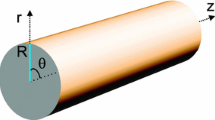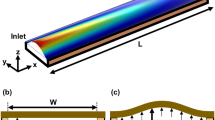Abstract
Large pressures can induce detrimental deformation in micro- and nanofluidic channels. Although this has been extensively studied for systems driven by pressure and/or capillary forces, deflection in electrokinetic systems due to internal pressure gradients caused by non-uniform electric fields has not been widely explored. For example, applying an axial electric field in a channel with a step change in conductivity and/or surface charge can lead to internally generated pressures large enough to cause cavitation, debonding, and/or channel collapse. Finite electric double layers within nanofluidic channels can further complicate the physics involved in the deformation process. In order to design devices and experimental procedures that avoid issues resulting from such deformation, it is imperative to be able to predict deformation for given system parameters. In this work, we numerically investigate pressures resulting from a step change in conductivity and/or surface charge in micro- and nanofluidic channels with both thin and thick double layers. We show an explicit relation of pressure dependence on concentration ratio and electric double layer thickness. Furthermore, we develop a numerical model to predict deformation in such systems and use the model to unearth trends in deformation for various electric double layer thicknesses and both glass and PDMS on glass channels. Our work is particularly impactful for the development and design of micro- and nanofluidic-based devices with gradients in surface charge and/or conductivity, fundamental study of electrokinetic-based cavitation, and other systems that exploit non-uniform electric fields.






Similar content being viewed by others
References
Abgrall P, Nguyen NM (2008) Nanofluidic devices and their applications. Anal Chem 80:2326–2341. doi:10.1021/ac702296u
Bharadwaj R, Santiago JG (2005) Dynamics of field-amplified sample stacking. J Fluid Mech 543:57. doi:10.1017/s0022112005005975
Bruin GJM (2000) Recent developments in electrokinetically driven analysis on microfabricated devices. Electrophoresis 21:3931–3951. doi:10.1002/1522-2683(200012)21:18<3931:AID-ELPS3931>3.0.CO;2-M
Dendukuri D, Gu SS, Pregibon DC, Hatton TA, Doyle PS (2007) Stop-flow lithography in a microfluidic device. Lab Chip 7:818–828. doi:10.1039/B703457A
Gervais T, El-Ali J, Gunther A, Jensen KF (2006) Flow-indeuced deformation of shallow microfluidic channels. Lab Chip 6:500–507. doi:10.1039/B513524A
Gillespie D (2015) A review of steric interactions of ions: why some theories succeed and others fail to account for ion size. Microfluid Nanofluid 18:717–738. doi:10.1007/s10404-014-1489-5
Hardy BS, Uechi K, Zhen J, Pirouz KH (2009) The deformation of flexible PDMS microchannels under a pressure driven flow. Lab Chip 9:935–938. doi:10.1039/B813061B
Herr AE, Molho JI, Santiago JG, Mungal MG, Kenny TW, Garguiloae MG (2000) Electroosmotic capillary flow with nonuniform zeta potential. Anal Chem 72:1053–1057. doi:10.1021/ac990489i
Hosokawa K, Hanada K, Maeda R (2001) A polydimethylsiloxane (PDMS) deformable diffraction grating for monitoring of local pressure in microfluidic devices. J Micromech Microeng 12(1):1
Hunter RJ (1981) Zeta potential in colloidal science: principles and applications. Academic press, San Diego, CA
Janssen KGH, Pennathur S (2015) Electrocavitation in nanofluidics: unique phenomenon and fundamental platform. Lab Chip 15:3980–3983. doi:10.1039/C5LC00692A
Janssen KGH, Eijkel JCT, Tas NR, de Vreede LJ, Hankemeier T, van der Linden HJ (2011) Electrocavitation in nanochannels. In: Proceedings MicroTAS, W2E. Seattle WA, USA
Lenzi A, Viola F, Bonotto F, Frey J, Napoli M, Pennathur S (2011) Method to determine the effective zeta potential in a microchannel with an embedded gate electrode. Electrophoresis 32:3295–3304
Loessberg-Zahl J, Janssen KGH, McCallum C, Gillespie D, Pennathur S (2016) (Almost) stationary isotachophoretic concentration boundary in a nanofluidic channel using charge inversion. Anal Chem. doi:10.1021/acs.analchem.6b01701
Majumder A, Tiwari AK, Korada K, Ghatak A (2010) Microchannel induced surface bulging of a soft elastomeric layer. J Adhes Sci Technol 24:2681–2692
Mijatovic D, Eijkel JCT, van den Berg A (2005) Technologies for nanofluidic systems: top-down vs. bottom-up-a review. Lab Chip 5:492–500. doi:10.1039/B416951D
Pennathur S (2001) Microscale turbopump cavitation. M.S. Thesis, Department of Aeronautics and Aerospace, MIT
Pennathur S, Santiago JG (2005) Electrokinetic transport in nanochannels: 2. Experiments. Anal Chem 77:6782–6789
Quake SR, Scherer A (2000) From micro- to nanofabrication with soft materials. Science 290:1536–1540. doi:10.1126/science.290.5496.1536
Sadr R, Yoda M, Zheng Z, Conlisk AT (2004) An experimental study of electro-osmotic flow in rectangular microchannels. J Fluid Mech 506:357–367
Squires TM, Quake SR (2005) Microfluidics: fluid physics at the nanoliter scale. Rev Mod Phys 77:977. doi:10.1103/RevModPhys.77.977
Unger MA, Chou HP, Thorsen T, Schherer A, Quake SR (2000) Monolithic microfabricated valves and pumps by multilayer soft lithography. Science 288:113–116
van Honschoten JW, Escalante M, Tas NR, Jansen HV, Elwenspoek M (2007) Elastocapillary filling of deformable nanochannels. J Appl Phys 101:094310
van Schoot DS, Janssen KG, Tas NR, Hankemeier T, Eijkel JCT (2014) Electrocavitation in nanochannels. In: Mercury L, Tas N, Zilberbrand M (eds) Transport and reactivity of solutions in confined hydrosystems. Springer, pp 141–150
Wainright A, Williams SJ, Ciambrone G, Xue Q, Wei J, Harris D (2002) Sample pre-concentration by isotachophoresis in microfluidic devices. J Chromatogr A 979:69–80
Xia Y, Whitesides GM (1998) Soft lithography. Annu Rev Mater Sci 28:153–184
Acknowledgments
This work was supported by the US Army Research Office under cooperative agreement W911NF-12-1-0031, and Institute for Collaborative Biotechnologies through grant W911NF-09-0001 from the US Army Research Office. The content of the information does not necessarily reflect the position or the policy of the Government, and no official endorsement should be inferred. The authors also acknowledge Peter de Rutte for his help with the literature search.
Author information
Authors and Affiliations
Corresponding author
Electronic supplementary material
Below is the link to the electronic supplementary material.
Rights and permissions
About this article
Cite this article
de Rutte, J.M., Janssen, K.G.H., Tas, N.R. et al. Numerical investigation of micro- and nanochannel deformation due to discontinuous electroosmotic flow. Microfluid Nanofluid 20, 150 (2016). https://doi.org/10.1007/s10404-016-1815-1
Received:
Accepted:
Published:
DOI: https://doi.org/10.1007/s10404-016-1815-1




